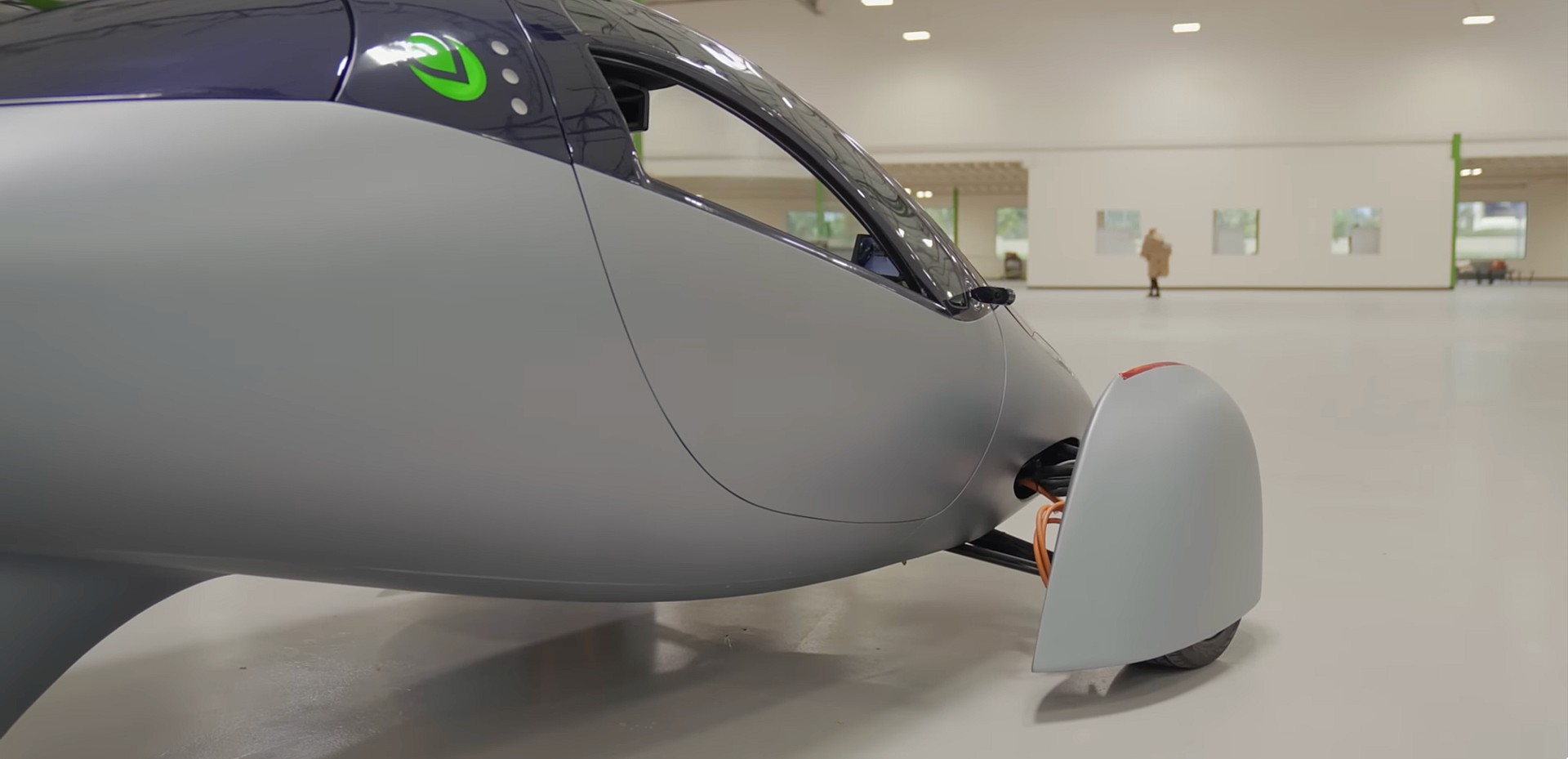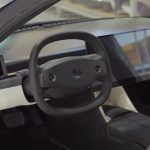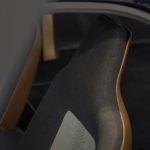

News
Aptera’s Gamma Alpha Prototype is as crazy as it is efficient in first hands-on look
Update 8/12: Headline and any reference to the vehicle has been changed to “Gamma Alpha Prototype.”
Aptera offered a hands-on look at a prototype of the Gamma Alpha solar-powered vehicle today, which is as crazy looking as it is efficient, thanks to a world-class drag co-efficient and incredibly sleek design.
The Fully Charged Show was given access to what Aptera called the “Alpha prototype” of their upcoming Gamma model. This vehicle was significantly more finished-looking than the “beta prototype,” where the complete drivetrain, suspension setup, and software were being tested, yet also looked quite different than the vehicle that was teased earlier this week.
Incredible efficiency with a world-class drag coefficient
The prototype shown in the video above has a 0.13 drag coefficient, which is significantly lower than other EV offerings on the market. The Lightyear Zero solar car has a 0.20 drag coefficient, while the Tesla Model 3 holds a 0.22 rating. The Lucid Air Dream Edition has a 0.21 drag coefficient, while the Tesla Model S Plaid has a 0.208.
Drag coefficients are a significant factor for electric vehicle efficiency. While Aptera has already achieved a world-class energy usage metric in terms of miles driven per kWh. The Tesla Model 3 will offer 5 miles of range per kWh, but the solar-powered Aptera Gamma prototype will give drivers an efficiency rating of double what the Model 3 will offer, and that is in no way an insult to the mass-market sedan from Tesla, which was noted as the “poster child of efficiency” by Fully Charged.
Polarizing interior designs
The Alpha Gamma prototype had some significant differences compared to the teased Aptera interior. A more normal-looking steering wheel replaced the ever divisive yoke, the driver dash screen was revealed to be the rearview mirror system, and the center divider/console appeared significantly more finished with a center armrest and center storage area. However, the interior matched the teaser image’s minimalism, lacking many physical controls, sunshades, and air conditioning vents.
One area shown on the video that was absent from the teaser images was the door. The interior door panel included a leather strap that would hang down to help close the door when sitting, a set of window controls that control the Subaru SVX style split windows, and otherwise remained sparse, matching the rest of the interior.
- Credit: Fully Charged Show | YouTube
- Credit: Fully Charged Show | YouTube
Technical information shared in the video includes Aptera’s “skin cooling” technology, whereby the vehicle’s underside is used as a heat sync to cool the batteries as the vehicle drives. The charging port was a Tesla connector underneath the rear license plate. And finally, the UI was described to have a lot of features that aimed to help the driver increase range whenever possible, mainly discouraging the use of AC and seat heaters.
Aptera has over 27,000 reservations for the Gamma so far. With the company holding a plan to start deliveries by next year, the vehicle could be introduced with a starting price under $20,000, which is amazingly affordable considering the efficiency the vehicle could ultimately offer.
What do you think of the article? Do you have any comments, questions, or concerns? Shoot me an email at william@teslarati.com. You can also reach me on Twitter @WilliamWritin. If you have news tips, email us at tips@teslarati.com!

News
Tesla starts showing how FSD will change lives in Europe
Local officials tested the system on narrow country roads and were impressed by FSD’s smooth, human-like driving, with some calling the service a game-changer for everyday life in areas that are far from urban centers.

Tesla has launched Europe’s first public shuttle service using Full Self-Driving (Supervised) in the rural Eifelkreis Bitburg-Prüm region of Germany, demonstrating how the technology can restore independence and mobility for people who struggle with limited transport options.
Local officials tested the system on narrow country roads and were impressed by FSD’s smooth, human-like driving, with some calling the service a game-changer for everyday life in areas that are far from urban centers.
Officials see real impact on rural residents
Arzfeld Mayor Johannes Kuhl and District Administrator Andreas Kruppert personally tested the Tesla shuttle service. This allowed them to see just how well FSD navigated winding lanes and rural roads confidently. Kruppert said, “Autonomous driving sounds like science fiction to many, but we simply see here that it works totally well in rural regions too.” Kuhl, for his part, also noted that FSD “feels like a very experienced driver.”
The pilot complements the area’s “Citizen Bus” program, which provides on-demand rides for elderly residents who can no longer drive themselves. Tesla Europe shared a video of a demonstration of the service, highlighting how FSD gives people their freedom back, even in places where public transport is not as prevalent.
What the Ministry for Economic Affairs and Transport says
Rhineland-Palatinate’s Minister Daniela Schmitt supported the project, praising the collaboration that made this “first of its kind in Europe” possible. As per the ministry, the rural rollout for the service shows FSD’s potential beyond major cities, and it delivers tangible benefits like grocery runs, doctor visits, and social connections for isolated residents.
“Reliable and flexible mobility is especially vital in rural areas. With the launch of a shuttle service using self-driving vehicles (FSD supervised) by Tesla in the Eifelkreis Bitburg-Prüm, an innovative pilot project is now getting underway that complements local community bus services. It is the first project of its kind in Europe.
“The result is a real gain for rural mobility: greater accessibility, more flexibility and tangible benefits for everyday life. A strong signal for innovation, cooperation and future-oriented mobility beyond urban centers,” the ministry wrote in a LinkedIn post.
News
Tesla China quietly posts Robotaxi-related job listing
Tesla China is currently seeking a Low Voltage Electrical Engineer to work on circuit board design for the company’s autonomous vehicles.

Tesla has posted a new job listing in Shanghai explicitly tied to its Robotaxi program, fueling speculation that the company is preparing to launch its dedicated autonomous ride-hailing service in China.
As noted in the listing, Tesla China is currently seeking a Low Voltage Electrical Engineer to work on circuit board design for the company’s autonomous vehicles.
Robotaxi-specific role
The listing, which was shared on social media platform X by industry watcher @tslaming, suggested that Tesla China is looking to fill the role urgently. The job listing itself specifically mentions that the person hired for the role will be working on the Low Voltage Hardware team, which would design the circuit boards that would serve as the nervous system of the Robotaxi.
Key tasks for the role, as indicated in the job listing, include collaboration with PCB layout, firmware, mechanical, program management, and validation teams, among other responsibilities. The role is based in Shanghai.
China Robotaxi launch
China represents a massive potential market for robotaxis, with its dense urban centers and supportive policies in select cities. Tesla has limited permission to roll out FSD in the country, though despite this, its vehicles have been hailed as among the best in the market when it comes to autonomous features. So far, at least, it appears that China supports Tesla’s FSD and Robotaxi rollout.
This was hinted at in November, when Tesla brought the Cybercab to the 8th China International Import Expo (CIIE) in Shanghai, marking the first time that the autonomous two-seater was brought to the Asia-Pacific region. The vehicle, despite not having a release date in China, received a significant amount of interest among the event’s attendees.
Elon Musk
Elon Musk and Tesla AI Director share insights after empty driver seat Robotaxi rides
The executives’ unoccupied tests hint at the rapid progress of Tesla’s unsupervised Robotaxi efforts.

Tesla CEO Elon Musk and AI Director Ashok Elluswamy celebrated Christmas Eve by sharing personal experiences with Robotaxi vehicles that had no safety monitor or occupant in the driver’s seat. Musk described the system’s “perfect driving” around Austin, while Elluswamy posted video from the back seat, calling it “an amazing experience.”
The executives’ unoccupied tests hint at the rapid progress of Tesla’s unsupervised Robotaxi efforts.
Elon and Ashok’s firsthand Robotaxi insights
Prior to Musk and the Tesla AI Director’s posts, sightings of unmanned Teslas navigating public roads were widely shared on social media. One such vehicle was spotted in Austin, Texas, which Elon Musk acknowleged by stating that “Testing is underway with no occupants in the car.”
Based on his Christmas Eve post, Musk seemed to have tested an unmanned Tesla himself. “A Tesla with no safety monitor in the car and me sitting in the passenger seat took me all around Austin on Sunday with perfect driving,” Musk wrote in his post.
Elluswamy responded with a 2-minute video showing himself in the rear of an unmanned Tesla. The video featured the vehicle’s empty front seats, as well as its smooth handling through real-world traffic. He captioned his video with the words, “It’s an amazing experience!”
Towards Unsupervised operations
During an xAI Hackathon earlier this month, Elon Musk mentioned that Tesla owed be removing Safety Monitors from its Robotaxis in Austin in just three weeks. “Unsupervised is pretty much solved at this point. So there will be Tesla Robotaxis operating in Austin with no one in them. Not even anyone in the passenger seat in about three weeks,” he said. Musk echoed similar estimates at the 2025 Annual Shareholder Meeting and the Q3 2025 earnings call.
Considering the insights that were posted Musk and Elluswamy, it does appear that Tesla is working hard towards operating its Robotaxis with no safety monitors. This is quite impressive considering that the service was launched just earlier this year.










